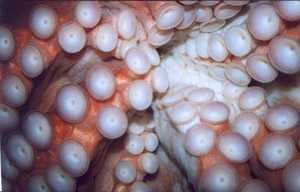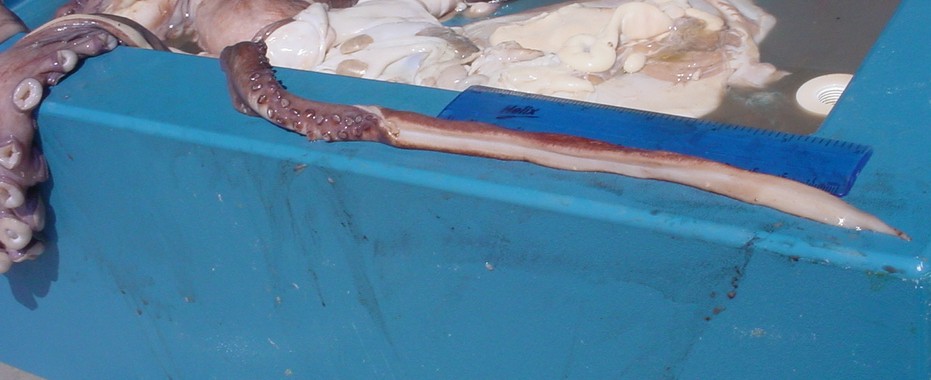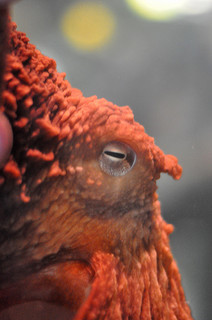Adaptations for Survival
The giant Pacific
octopus has developed many adaptations in order for it to survive in
its environment. Some of the more interesting adaptations are
described
below.
Arms: Like all octopuses, the Pacific
octopus has eight arms. The two rear-most arms function as "legs."
They are used to push off of the ocean floor, anchor itself
in one place, and crawl over rocks and debris. The other six arms
are used as “arms” are expected to be used. They grab objects,
feel around, and feed the octopus. Every arm contains both radial and
longitudinal muscles. This muscle combination makes them very
strong. The arms are able to resist a pull one hundred times the
octopus’s weight, which is roughly 4,000 pounds. There are no bones
in the Pacific octopus's arms, or its entire body either, which
allows the arms to be very flexible. This flexibility is useful and
allows the octopus to fit the arms into small crevices.

Suckers: Each arm of the Pacific octopus
contains about 280 suckers. The suckers play an important role in
both the octopus’s sense of touch and taste. Each sucker is believed
to contain thousands of chemical receptors. The rims
of the suckers are a particularly sensitive area to touch. It is
expected that a blindfolded octopus could differentiate objects by sense
of touch as easily as the octopus could sense an object using its sense of sight.
The suckers are also able to create a suction and
grip onto prey or the substrate.
Hectocotylus: This is a reproductive
organ found only on the male octopuses. It makes up a male's third right arm. This arm stands out because it is the only arm that does not contain the full amount of
suckers. The last fifth of the arm, instead, has a ciliated crease
running down the center. The terminal portion of the hectocotylus is called the
ligula, which contains erectile tissue. The ligula does not have any
chromatophores, however, so males frequently keep it curled up to
maintain their camouflage. More details of the male's use of the hectocotylus
can be found on the reproduction page.
because it is the only arm that does not contain the full amount of
suckers. The last fifth of the arm, instead, has a ciliated crease
running down the center. The terminal portion of the hectocotylus is called the
ligula, which contains erectile tissue. The ligula does not have any
chromatophores, however, so males frequently keep it curled up to
maintain their camouflage. More details of the male's use of the hectocotylus
can be found on the reproduction page.
Statocyst: The statocyst receptors are
used by this octopus to detect angular rotation. They are able to use
detect rotation in three planes, at right angles to each other. This
way the octopus determine its body’s orientation in relation to the
ocean floor. It uses hair cells, along with gravity, to complete
this task. It may also use these hair cells, along with vibrations,
to “hear.” Octopuses have been found to be most sensitive to
lower-frequency vibrations.

Eyes: Pacific octopuses have very advanced eye structures. They contain many of the parts that human
eyes do, including: the iris, the pupil, the lens, the retina, and
the optic nerve. However, the pupil is not a round shape, but is a horizontal
slit. When focusing, the octopus’s eye moves the lens forward and
backward, instead of altering its curvature like humans. The eye is one of the
most important senses to the Pacific octopus. It uses its sense of
vision to choose a mate, find a den, blend in with its environment, and locate prey.
Brain: This invertebrate is a very
intelligent creature and has a complete nervous system. Since it
does not have many defensive adaptations, it must use its brain to survive. The intelligence of these octopuses has undergone
much research. More information about it can be found here:
Intelligence.
Hearts: This octopus has three hearts.
They each pump blood through the octopus’s closed circulatory
system. This system also includes: veins, arteries and capillaries. Two of
the hearts pump blood to the two gills and the third heart pumps blood to the
rest of the octopus's body. The blood also contains the important oxygen-transporting
molecule, hemocyanin.
Chromatophores: Camouflage is an
important method of defense used by the Pacific octopus.
Chromatophores are the pigmentation sacs that allow octopuses to blend into their surroundings so
flawlessly. Each chromatophore is made up of three different pigment
sacs: yellow, red, and brown. The colored appearance of the octopus’s skin
is determined by small muscles. These muscles will pull a
colored pigment sac to the
surface to make that color is visible. When the muscle relaxes, the
pigmentation from that sac goes away. The octopus uses its eyes to
judge the color and texture of the camouflage it wants to wear. Working in conjugation
with chromatophores are papillae. These small muscles under the skin
are able to form the skin into peaks of varying heights. This allows
the octopus to look rough or smooth, whichever blends in best with
its current environment. Finally, males innately know which skin
patterns to flash at females during in the courting process of
reproduction.
sacs that allow octopuses to blend into their surroundings so
flawlessly. Each chromatophore is made up of three different pigment
sacs: yellow, red, and brown. The colored appearance of the octopus’s skin
is determined by small muscles. These muscles will pull a
colored pigment sac to the
surface to make that color is visible. When the muscle relaxes, the
pigmentation from that sac goes away. The octopus uses its eyes to
judge the color and texture of the camouflage it wants to wear. Working in conjugation
with chromatophores are papillae. These small muscles under the skin
are able to form the skin into peaks of varying heights. This allows
the octopus to look rough or smooth, whichever blends in best with
its current environment. Finally, males innately know which skin
patterns to flash at females during in the courting process of
reproduction.
Mouth: The mouth structure on the
Pacific octopus contains many important feeding
adaptations. A beak, which greatly resembles a parrot’s, is sharp
and used to bite and grasp prey. Inside the beak is a radula. This
is a very rough tongue-like structure that contains ribbons of small
teeth. The radula is used to scrape up their prey, often from within the
prey's own
shell! Salivary glands within the octopus’s mouth region contain
venom. The venom is used both to paralyze the prey and begin the
octopus's
digestion process. The venom is passed out through the salivary
papillae. At the end of the salivary papillae is a set of drill-shaped
teeth. These teeth are used to bore holes into the shells of the octopus’s
prey.
Siphon: The siphon can be found near the
base of the octopus’s mantle (the round-shaped head/body area.) The
siphon is a primary player in the Pacific octopus's respiration. Water flows
into the gill slit, goes past the gills, and is ejected out of the
tube-shaped siphon.(A video of this can be seen
here. With the use of quick muscular contractions, the octopus
is able to rapidly shoot the water out of the siphon. This allows
the octopus to zoom away, head-first, using jet propulsion. Under the
octopus’s digestive gland is the ink production gland. The ink is
produced here, then
stored in a larger sac, which is near the siphon. On a command,
usually triggered by fear, the octopus releases the ink. Before
being squirted out, the
ink mixes with mucus. The ink solution is then expelled out of the
siphon's opening. This causes the allows the octopus to use jet
propulsion and flee in the opposite direction since the attacker is
unable to see through the ink.
Back to Nutrition Forward to Reproduction